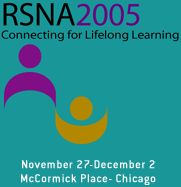
Abstract Archives of the RSNA, 2005
LPR03-01
Lung Perfusion Ratios Calculated with Quantitative Perfusion MRI: A Comparison with Radionuclide Perfusion Scans
Scientific Posters
Presented on December 1, 2005
Presented as part of LPR03: Chest (MR Perfusion, Technique)
Francesco Molinari MD, Presenter: Nothing to Disclose
Christian Fink MD, Abstract Co-Author: Nothing to Disclose
Frank Risse, Abstract Co-Author: Nothing to Disclose
Tristan Anselm Kuder, Abstract Co-Author: Nothing to Disclose
Lorenzo Bonomo MD, Abstract Co-Author: Nothing to Disclose
Hans-Ulrich Kauczor MD, Abstract Co-Author: Nothing to Disclose
To assess the agreement between perfusion ratios calculated from quantitative perfusion MRI with those from radionuclide (RN) perfusion scans.
A retrospective analysis of MR and RN perfusion scans was carried out in 23 patients (mean age 60y ±14) with various pulmonary diseases. Pulmonary perfusion was assessed by a time-resolved contrast-enhanced 3D gradient echo pulse sequence using parallel imaging (TR=1.9ms; TE=0.8ms; flip angle=40°). Full coverage of the lung was obtained with a 3D-slab of 18 cm. Partition thickness and temporal resolution were 4-mm and 1.5sec, respectively. Quantitative analysis of MR perfusion data was performed using an inhouse-developed software. Maximum peak concentration (MPC), regional pulmonary blood flow (PBF), pulmonary blood volume (PBV) were computed from the time-intensity curves of the lung. Left-to-right ratios of pulmonary perfusion were calculated with both MR parametric data (L/R-MR-MPC, L/R-MR-PBF, L/R-MR-PBV) and RN counts (L/R-RN). Sign test was used to assess the agreement in the side prevalence of differential lung perfusion (L/R > 1 [left]; L/R < 1 [right]). Deming regression and Bland-Altman analysis were used to assess the quantitative agreement between L/R-MR and L/R-RN.
The side prevalence of L/R-RN was correctly estimated in 21 patients by L/R-MR-MPC (91.3%; p<0.01), in 20 by L/R-MR-PBF (86.9%; p<0.01), in 17 patients by L/R-MR-PBV (73.9%; p<0.01). A moderate correlation was found in the Deming regression model between L/R-MR and L/R-RN (L/R-MR-MPC: r=0.67, p<0.01; L/R-MR-PBF: r=0.66, p<0.01; L/R-MR-PBV: r=0.50, p<0.01). L/R-MR-PBF was most accurate in estimating L/R-RN. Wide intervals of agreement were found between all L/R-MR and L/R-RN in the Bland-Altman analysis (L/R-MR-MPC: ±60.02%; L/R-MR-PBF: ±62.79%; L/R-MR-PBV: ±67.63).
Similarly to conventional RN perfusion scintigraphy, lung perfusion MRI could rapidly and intuitively estimate the left-to-right ratios of pulmonary perfusion using a semiquantitative analysis. However, different quantities are measured with these two methods. Furthermore, the clinical impact of quantitative perfusion MRI of the lung has to be fully elucidated yet.
To assess the agreement between perfusion ratios calculated from quantitative perfusion MRI with those from radionuclide (RN) perfusion scans.
A retrospective analysis of MR and RN perfusion scans was carried out in 23 patients (mean age 60y ±14) with various pulmonary diseases. Pulmonary perfusion was assessed by a time-resolved contrast-enhanced 3D gradient echo pulse sequence using parallel imaging (TR=1.9ms; TE=0.8ms; flip angle=40°). Full coverage of the lung was obtained with a 3D-slab of 18 cm. Partition thickness and temporal resolution were 4-mm and 1.5sec, respectively. Quantitative analysis of MR perfusion data was performed using an inhouse-developed software. Maximum peak concentration (MPC), regional pulmonary blood flow (PBF), pulmonary blood volume (PBV) were computed from the time-intensity curves of the lung. Left-to-right ratios of pulmonary perfusion were calculated with both MR parametric data (L/R-MR-MPC, L/R-MR-PBF, L/R-MR-PBV) and RN counts (L/R-RN). Sign test was used to assess the agreement in the side prevalence of differential lung perfusion (L/R > 1 [left]; L/R < 1 [right]). Deming regression and Bland-Altman analysis were used to assess the quantitative agreement between L/R-MR and L/R-RN.
The side prevalence of L/R-RN was correctly estimated in 21 patients by L/R-MR-MPC (91.3%; p<0.01), in 20 by L/R-MR-PBF (86.9%; p<0.01), in 17 patients by L/R-MR-PBV (73.9%; p<0.01). A moderate correlation was found in the Deming regression model between L/R-MR and L/R-RN (L/R-MR-MPC: r=0.67, p<0.01; L/R-MR-PBF: r=0.66, p<0.01; L/R-MR-PBV: r=0.50, p<0.01). L/R-MR-PBF was most accurate in estimating L/R-RN. Wide intervals of agreement were found between all L/R-MR and L/R-RN in the Bland-Altman analysis (L/R-MR-MPC: ±60.02%; L/R-MR-PBF: ±62.79%; L/R-MR-PBV: ±67.63).
Similarly to conventional RN perfusion scintigraphy, lung perfusion MRI could rapidly and intuitively estimate the left-to-right ratios of pulmonary perfusion using a semiquantitative analysis. However, different quantities are measured with these two methods. Furthermore, the clinical impact of quantitative perfusion MRI of the lung has to be fully elucidated yet.
Molinari, F,
Fink, C,
Risse, F,
Kuder, T,
Bonomo, L,
Kauczor, H,
Lung Perfusion Ratios Calculated with Quantitative Perfusion MRI: A Comparison with Radionuclide Perfusion Scans. Radiological Society of North America 2005 Scientific Assembly and Annual Meeting, November 27 - December 2, 2005 ,Chicago IL.
http://archive.rsna.org/2005/4410583.html

